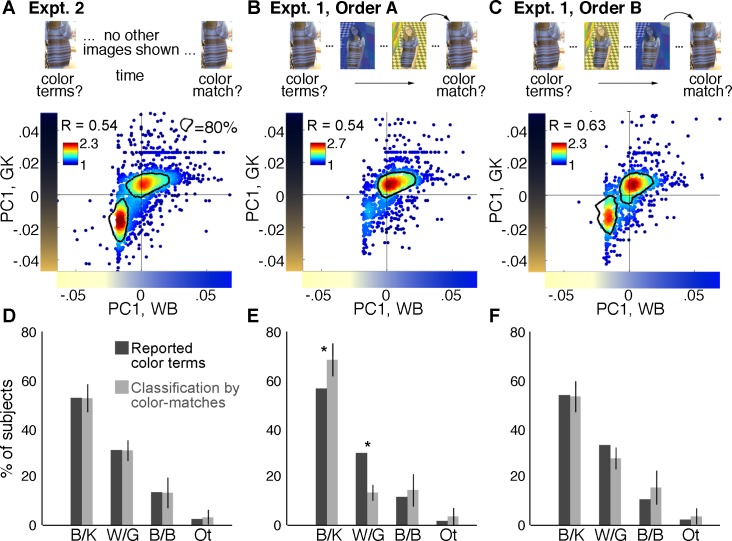Figure 15.
Priming with disambiguated scenes of the dress affects subsequent viewings, providing evidence that priors on lighting conditions can be updated by short-term experience. Two experiments were conducted with separate groups of subjects. In Experiment 1, subjects gave color matches for the original dress image immediately after viewing the disambiguating stimuli from Figure 13; in Experiment 2, subjects were never exposed to the disambiguating stimuli. In Experiment 1, two groups of subjects saw the disambiguating stimuli in one of two orders that differed depending on which disambiguating stimulus immediately preceded the color-matching task. All subjects provided verbal reports prior to viewing the disambiguating stimuli. (A) Analysis of data from Experiment 2 (online subjects: N = 1,126). The scatterplot (conventions as in Figure 1A) shows two peaks. (B) Analysis of color-matching data from Experiment 1, Order A (N = 553; subjects viewed the simulated warm scene—the B/K primer—directly before performing the color-matching task on the original image). K-means clustering returns two clusters, but there is one dominant peak. (C) Analysis of color-matching data from Experiment 1, Order B (N = 523; subjects viewed the simulated cool scene—the W/G primer—directly before the color-matching task on the original image). The scatterplot has two strong peaks. (D) Histograms comparing the distribution of categorical percepts recovered in Experiment 2 (control, no-primer) during the verbal task and the color-matching task. Dark-gray bars show data from the verbal reporting task; light-gray bars show the distribution of verbal reports predicted from the color matches using the category-response model (see Figure 7A; the classifier was trained on half the data and the plot shows classification for the other half). Error bars show 95% confidence intervals. Distributions do not differ. (E) Bar plots showing the distribution of categorical percepts for Experiment 1, Order A. Dark bars show verbal reports collected prior to priming; light bars show verbal labels predicted from color matches made following exposure to the B/K primer. Asterisks indicate a significant shift from W/G to B/K reporting after B/K priming (dark bar falls outside of the 95% confidence interval of the light bar). (F) Histograms comparing distributions for WG primer (Experiment 1, Order B). Photograph of the dress used with permission; copyright Cecilia Bleasdale.

